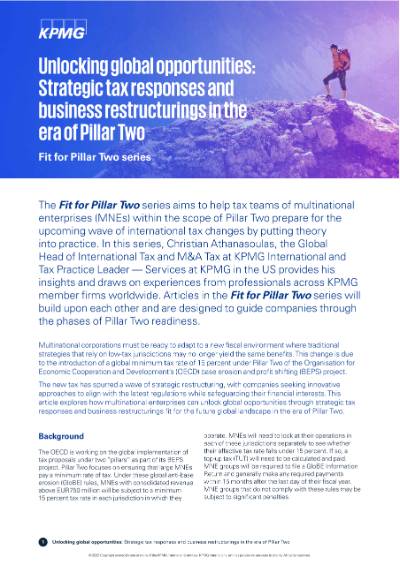The OECD is working on the global implementation of tax proposals under two “pillars” as part of its BEPS project. Pillar Two focuses on ensuring that large Multinational Enterprises (MNEs) pay a minimum rate of tax. Under these global anti-base erosion (GloBE) rules, MNEs with consolidated revenue above EUR750 million will be subject to a minimum 15 percent tax rate in each jurisdiction in which they operate. MNEs will need to look at their operations in each of these jurisdictions separately to see whether their effective tax rate falls under 15 percent. If so, a top-up tax (TUT) will need to be calculated and paid. MNE groups will be required to file a GloBE Information Return and generally make any required payments within 15 months after the last day of their fiscal year. MNE groups that do not comply with these rules may be subject to significant penalties.
Challenges and opportunities
In response to the global implementation of Pillar Two, multinational corporations are reconsidering their global effective tax rate building blocks and business structures.
With the introduction of a global minimum tax rate of 15 percent, companies are compelled to navigate a drastically altered fiscal landscape, where traditional strategies that rely on low-tax jurisdictions may no longer yield the same benefits. This shift has spurred a wave of strategic restructuring, with firms seeking innovative approaches to align with the new regulations while safeguarding their financial interests.
The ongoing evolution of the OECD's administrative guidance on Pillar Two adds another layer of complexity to this already challenging scenario. Companies must remain agile, adapting their strategies in real-time to comply with the emerging details of the rules.
Key takeaways for tax leaders managing through Pillar Two
- Multinational corporations must be ready to navigate a drastically altered fiscal landscape where traditional strategies that rely on low-tax jurisdictions may no longer yield the same benefits.
- Significant opportunities exist for tailored business restructuring that can optimize tax positions under the new global tax regime.
- Comprehensive Pillar Two impact assessments allow companies to evaluate planning opportunities more effectively.
- Many companies’ business restructuring focuses on legal entity rationalization, retrofitting structures and tax attribute optimization.
- Other strategic responses include using transitional safe harbors, developing longer-term strategies and reviewing new incentives.
- Leveraging technology and modeling solutions like the KPMG BEPS 2.0 Automation Technology (KBAT) are critical for groups wanting to get ahead of the curve and adopt best-in-class responses to Pillar Two.
Related content
Why work with KPMG in Thailand
KPMG in Thailand, with more than 2,500 professionals offering Audit and Assurance, Legal, Tax, and Advisory services, is a member firm of the KPMG global organization of independent member firms affiliated with KPMG International Limited, a private English company limited by guarantee.



